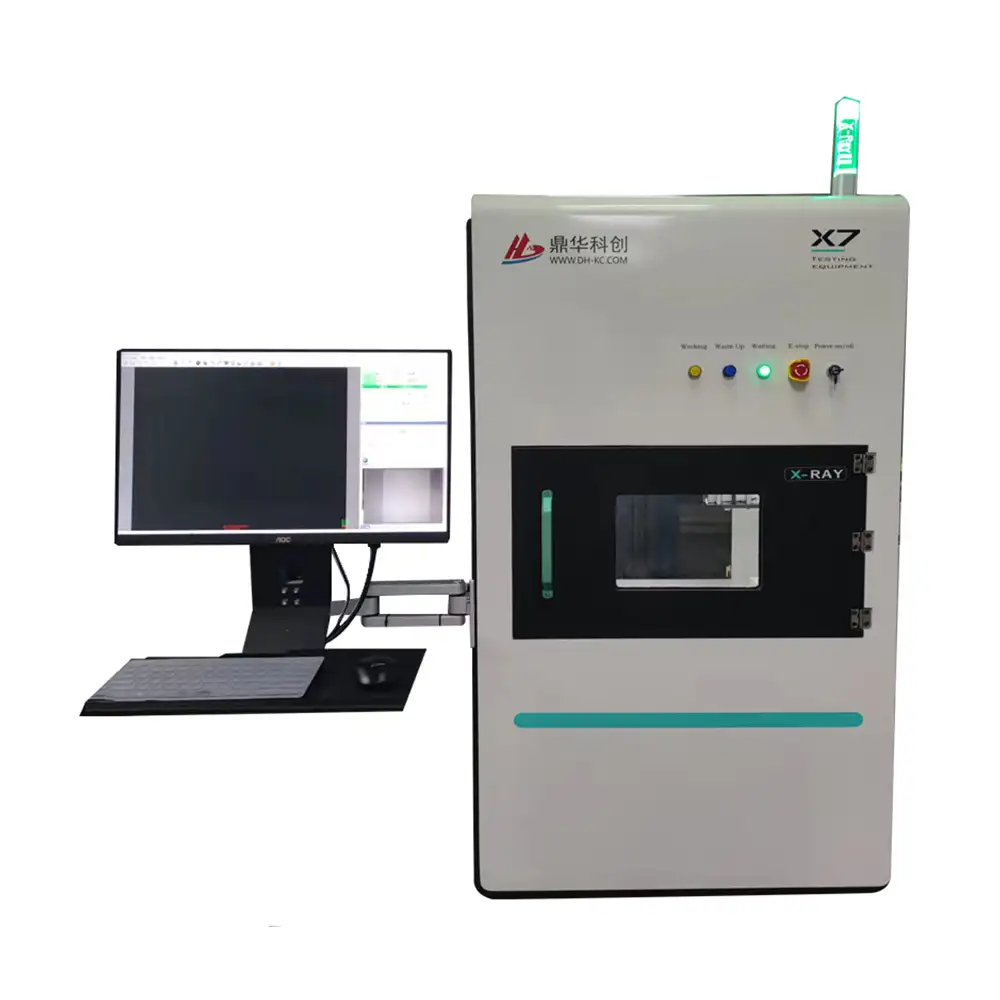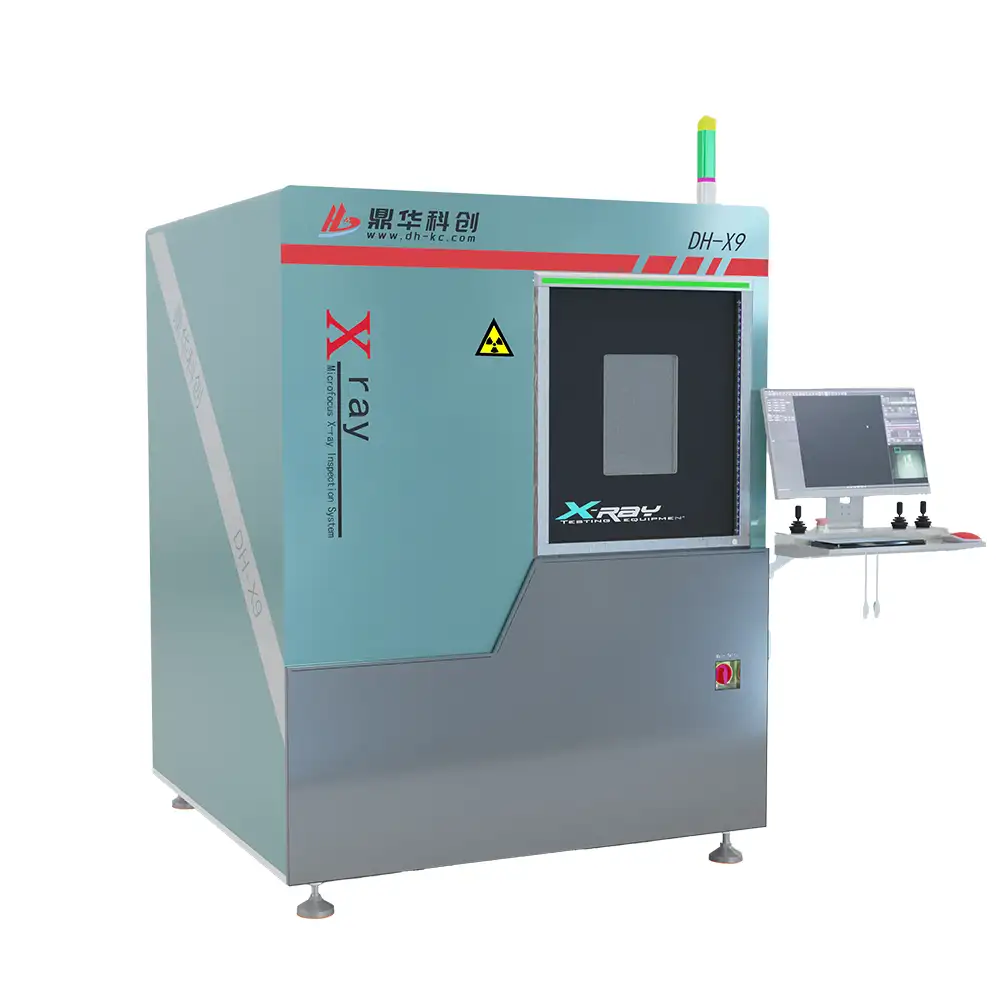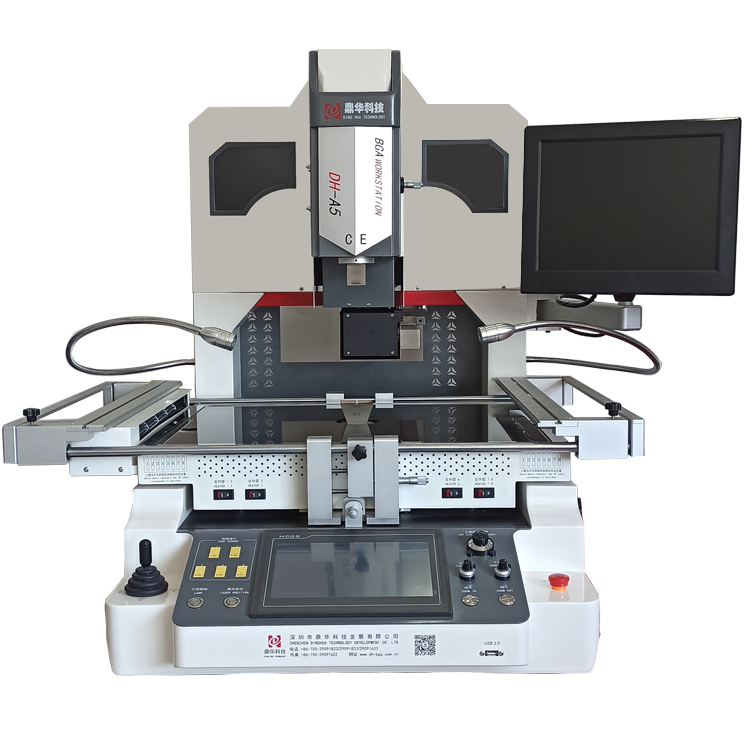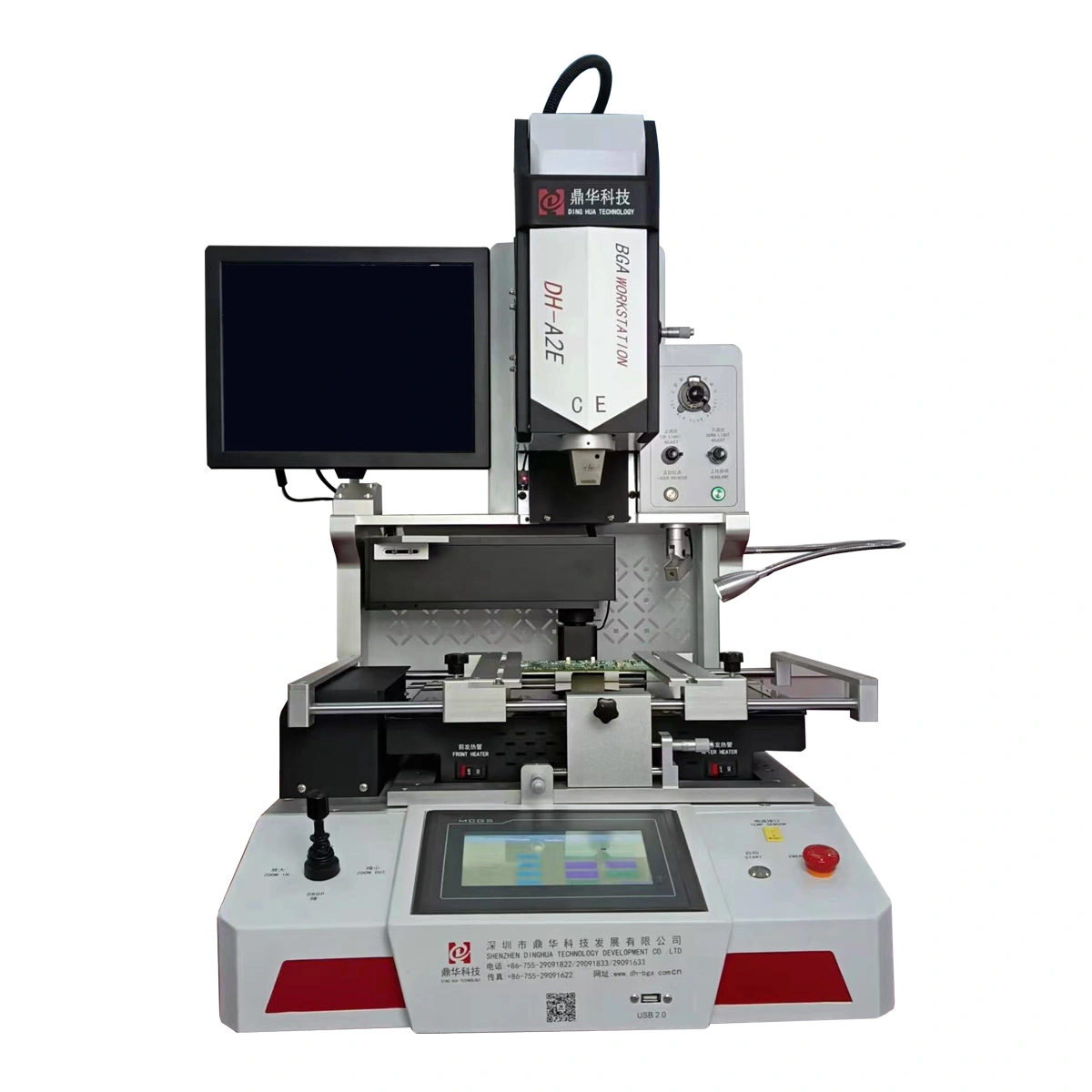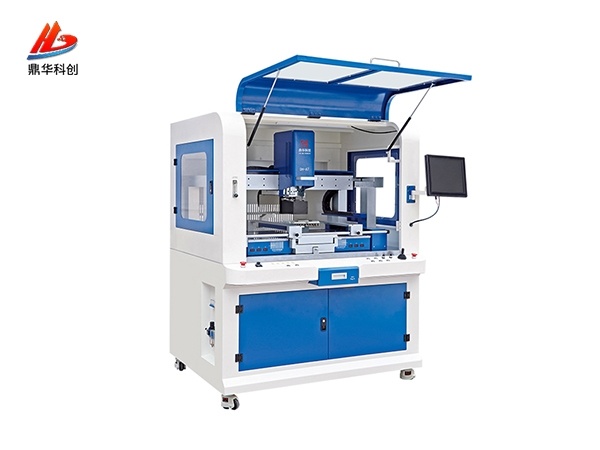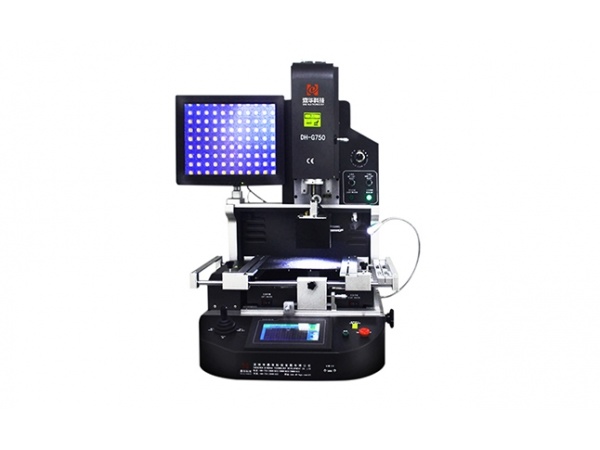专业设备制造商
BGA、QFN、CSP器件焊点空洞分析
2023-11-23
在SMT生产中,无引脚元器件如BGA、QFN、CSP等在焊接过程中,无论是回流焊还是波峰焊,无论是无铅还是无铅工艺,在冷却后不可避免地容易出现空洞 (气泡) 现象。焊点内部空隙的主要原因是助焊剂中有机物高温分解产生的气泡不能及时逸出。回流区的助焊剂已经完全消耗,焊膏的粘度发生了明显的变化。此时,焊膏中的助焊剂已经破裂,导致高温破裂的气泡无法及时逸出并被焊球包围。在冷却之后,形成空隙现象。目前,一般使用x射线设备来检查空隙的区域,通过x射线可以看到焊球中空隙的分布。有些器件只要腔体面积所占的比例不是很大,往往就认为符合验收标准 (如IPC-A-610D 8.2.12.4),因此在检查时没有得到足够的重视。
在众多空隙现象中,已经发现空隙现象的发生与焊料材料本身的表面张力直接相关。焊膏的表面张力越高,高温破裂的气泡越难从焊球中逸出,气泡被焊球内的团簇包围 (无铅焊料的表面张力达到4.60 × 10-3 N/260 ℃)。表面张力越低,高温开裂的气泡越容易从焊球中逸出,被焊球簇包围的概率相对较小 (铅焊料的表面张力达到3.80 × 10-3 N/260 ℃,Sn63-Pb37,m.p为183 ℃)。已经陷入高温开裂的气泡,当存在高密度的铅焊料 (约8.44g/cm3) 时,焊料中的合金在相互压力下会逸出到外部,因此有机物质残留在焊点中的概率很小,但是无铅是完全不同的。无铅焊料的比重不仅比铅小,而且无铅焊料的表面张力比铅高得多,熔点高达34 ℃ (Sn63-Pb37,熔点为183 ℃,SAC305熔点约为217 ℃)。在各种不利的环境条件下,无铅焊料中的有机物难以从焊料球中分解,并且有机物经常被焊料球包围,在冷却后形成空隙。
In terms of the reliability of solder joints, the phenomenon of voids can bring unpredictable risks to solder joints. At the same time, if the void phenomenon is severe, it can also affect the electrical connection of solder joints and the smoothness of circuits. So the phenomenon of voids must be highly valued by SMT industry professionals.
1. Acceptance criteria for voids
Most of the acceptance criteria for voids in the industry have not been determined. Based on some preliminary definitions in the IPC-A-610D version (8.2.12.4 Surface Mount Array Voids), we can draw the following conclusions: reducing the generation of voids in design, that is, micro holes on solder pads are not considered in this standard. The hollow standards are negotiated between the customer and the manufacturer. Manufacturers can use the results of various experimental analyses to develop final acceptance criteria for voids.
Acceptable levels -1, 2, 3
The area of the cavity is less than 25% of the X-ray image of the solder ball.
Defects - Level 1, 2, 3
The area of the solder ball X-ray image with a void greater than 25%.
The above IPC only mentions the BGA cavity acceptance standard, but many international manufacturers do not recognize this standard, which is even stricter and more demanding than this standard. For example, IBM believes that the void area of BGA should not exceed 15%. If it exceeds 20%, it will affect the reliability of solder joints and their service life. Of course, the smaller the void area, the better, as smaller void areas require stronger processes to support. However, IPC-A-610D does not have corresponding regulations for bubbles (voids) in QFN, and IPC has not explained this point. It is truly regrettable! At present, many QFN devices are used in the field of optical fiber communication, which requires high requirements for bubbles.
2 Causes and Improvement of Voids
2.1 Influence of Flux Activity Strength
如前所述,空隙的出现主要是由于助熔剂中有机化合物的高温开裂,产生难以逸出的气泡,导致气体被困在合金粉末中。从过程中可以看出,关键在于有机物高温开裂产生的气泡,其中有机物存在的主要方式有: 焊膏中的助焊剂、其他有机物、波峰焊助焊剂或浮渣的产生等。高温裂解后,上述各种有机化合物形成气体。由于气体的比重相对较小,它们将在回流期间悬浮在焊料的表面上,并最终逸出而不会停留在合金粉末的表面上。但是,在焊接时,必须考虑焊料的表面张力和焊接组件的重力。因此,有必要通过结合焊膏的表面张力和组件本身的重力来分析为什么气体不能从合金粉末的表面逸出并形成空隙。如果有机物产生的气体的浮力小于焊料的表面张力,则助焊剂中的有机物在高温开裂后会被困在焊料球内部,气体会被焊料球深深地吸收。此时,气体难以逸出,并且将形成空隙现象。
我们可以从焊膏制造商那里了解助焊剂活性的强度,溶剂沸点等。然而,当存在更多的通量和更强的活性时,空隙形成的可能性相当小,并且即使发生空隙现象,空隙形成的面积也相当小。原因是焊剂具有很强的活性,削弱了其在焊接界面的氧化能力,增强了焊接表面污垢和氧化物的去除。此时,在待焊接表面上露出清洁的金属层,焊膏将具有良好的扩散和润湿性能。焊接中出现的焊料排斥和收缩现象大大减少,因此残留焊剂被包围的可能性也很小。当然,空隙形成的可能性将降低。如果焊剂的活性不强,则待焊接表面上的污垢和氧化物不易去除,并且表面氧化物和污垢会残留在焊接金属的表面,从而阻止合金粉末焊接到焊接金属的表面,并形成不良的IMC合金层。如果被焊接的表面严重,此时不可能形成Cu6Sn5IMC合金层,我们通常认为是焊料排斥或锡收缩现象。
2.2 Related to the viscosity of FLUX in solder paste
If the viscosity of the flux is relatively high, the content of rosin is also relatively high. At this point, the flux has a stronger ability to remove surface oxides and dirt, greatly reducing the phenomenon of tin shrinkage and solder rejection. Welding will form a good IMC alloy layer, reducing bubbles and improving the mechanical strength of the solder joint. At the same time, the electrical performance of the solder joint will also be enhanced.
2.3 Related to the degree of oxidation on the surface of the solder pad
焊盘表面的氧化和污染程度越高,焊接后产生的空隙就越多。因为PAD的氧化程度越大,需要极强的活化剂来驱走焊接物体表面上的氧化物。特别是在OSP (有机可焊性防腐剂) 表面处理中,OSP垫上的有机保护膜层很难去除。如果焊盘表面的氧化物不能及时赶走,氧化物就会留在被焊接物体的表面。此时,氧化物将阻止合金粉末与焊接金属表面接触,从而形成不良的IMC,并且会发生锡收缩 (焊料排斥) 现象。表面氧化比较严重,有机物高温分解产生的气体会隐藏在合金粉末中。同时,无铅表面张力高,合金具有相对较高的密度,因此气体难以逸出,气体将被合金粉末包围。当然,虚空是自然形成的。如果要避免此类现象,则必须避免在焊接金属表面出现焊膏和氧化物。否则,没有其他方法可以减少空隙或锡收缩 (焊料排斥)。
2.4 Influence of solvent boiling point
无论是波峰焊前的溶剂还是焊膏本身,两者之间的沸点直接影响BGA空隙的大小和空隙形成的概率。溶剂的沸点越低,形成空隙的可能性越高。因此,可以使用高沸点溶剂以避免空隙的出现。如果溶剂的沸点较低,则溶剂已经在恒温区或回流区中蒸发,仅留下难以移动且必须被簇包围的高粘度有机化合物。同时,尽量不要将PCB印刷的焊膏长时间留在空气中 (通常在2小时内完成操作),以避免焊膏从空气中吸收水分或因与空气联系我们而导致氧化。这将进一步增加空隙现象的发生。所以在选择焊膏时,尽量使用高沸点溶剂,以减少空隙的发生。
2.5 Different surface treatment methods for PCB
At present, there are six main methods for surface treatment in the industry:
① Organic protective film (OSP, Organic Solderability Preservatives)
② Nickel immersion gold (ENIG, Electroless Nickel and Immersion Gold)
③ Immersion silver plating (I-Ag, Immersion Silver)
④ Immersion Tin (I-Sn)
⑤ Immersion bismuth (I-Bi, Immersion Bismuth)
⑥ Spray tin (HASL, Hot Air Solder Levelling)
以上六种是目前工业上使用的不同的表面处理方法。对于不同的表面处理,空隙形成的机理是相同的,但是空隙形成的概率和数量是不同的。其中,OSP表面处理产生的空洞现象较为明显,其保护膜与焊盘界面处出现空洞的概率也最高。保护膜越厚,产生空隙的可能性越高。OSP的厚度通常在0.2微米至0.5微米之间,优选约0.35微米。OSP的厚度可以使用UV分光光度计或扫描电子显微镜能谱仪 (SEM EDS) 测量。如果OSP的保护膜太厚并且助焊剂的活性强度不足,则难以在回流焊接期间驱走保护膜。如果不能很好地控制回流焊的温度曲线,也会导致OSP保护膜在高温环境下再次氧化。如果不驱走保护膜,这层膜会阻碍IMC层的形成,如果严重,会导致锡收缩或焊料排斥。如果在高温区发生第二次氧化,结果令人担忧。发生高温二次氧化现象,即使在焊盘上施加助焊剂或焊膏并再次回流焊后,焊料排斥或收缩的问题仍然不明显。由此可见,控制OSP保护膜的厚度非常重要,因此PCB制造商必须严格控制OSP表面处理工艺,以避免下游组装生产中不必要的纠纷。至于表面处理如ENIG,HASL,i-sn,i-ag,i-bi等,它们也会产生空隙,但它们产生空隙的概率相似,与此时的表面处理方法没有太大区别。换句话说,空隙的发生是由许多因素组成的,而不是由单一因素决定的。
2.6 Relationship with Reflux Curve (Profile)
当型材曲线在生产线上使用时间超过熔点 (通常在217 ℃ 以上30-60秒) 时,助焊剂中的挥发性物质会被排出,导致助焊剂粘度变化或助焊剂被烧干,开裂后甚至无法移动。这样,气体将被包围并且不能移动,导致空隙的形成。如果不可能施加锡或锡施加时间相对较慢,则所产生的空隙将更加明显。以前的Sn63Pb37的熔点为183 ℃,高于熔点的时间相对较短 (通常在60秒内),这大大减少了空隙的产生。与无铅焊接相比,锡膏的熔点比铅锡膏高34 ℃ 之多,其熔点以上的时间也比铅锡膏高得多。此外,无铅焊接的各个阶段和部分相对较长,这对助焊剂的活性提出了新的挑战,并且需要强助焊剂来帮助焊接。通常,恒温区 (150 ℃ ~ 190 ℃) 以上的时间控制在60 s ~ 120 s之间,峰值温度控制在235 ℃ ~ 245 ℃ 之间,特别是在240 ℃,这对BGA气泡控制相当好。当然,在进行温度控制的同时,应该注意的是,不同BGA的温度控制是不同的,这取决于BGA封装方法、尺寸以及BGA肚皮焊球的工艺,不能一概而论。这是理解和设置温度的正确且合乎逻辑的方法。同时,也可以参考BGA的零件认可证书。具体BGA设计和组装工艺的实现请参见BGA的IPC-7095设计和组装工艺实现。
2.7 Related to the tinning time of components
The tinning time of Sn63-Pb37 solder is very short, about 0.6 seconds, while the tinning time of SnAgCu solder is about 1.5 seconds. At the same time, lead-free solder has high surface tension, very slow movement speed, and poorer wetting and diffusion properties compared to lead solder. In these cases, it is difficult for the gas generated by the high-temperature cracking of organic matter to escape, and the gas will be completely surrounded in the alloy layer. Of course, the probability of voids generated by lead-free materials is much higher than that of voids generated by lead materials, which is also a difficult and challenging issue facing lead-free soldering today.
2.8 Influence of Solder Pad Area Size
When BGA substrates use adhesive soldering flux for ball placement, if the solder pad area of the ball placement is relatively large, it is easy to cause voids. And when the radius R of the ball is relatively large and the solder ball is relatively flat, the phenomenon of voids is also quite obvious. Because the area of the solder pad is large and the solder ball is relatively flat, more and stronger flux is needed to assist in soldering, resulting in more residual organic matter after high-temperature cracking. The path and distance for organic matter to escape also increase because the area of the solder pad increases. So the size of the solder pad area can also affect the occurrence of BGA voids.
2.9 Excessive inhalation of moisture in the air caused by solder paste
焊膏应以正确的方式使用。从冰箱中取出锡膏时,应使其在室温 (25 ℃ ± 3 ℃) 下预热至少4小时。在锡膏加热过程中,重要的是不要提前打开锡膏的盖子或通过加热将其加热。同时,避免吸入空气中的水分。在线使用焊膏之前,有必要将焊膏搅拌均匀,以确保合金粉末和助焊剂搅拌均匀。搅拌时间不应太长 (约3分钟),搅拌力不应太强。如果时间太长且力太强,则合金粉末很可能被压碎,从而导致焊膏中的金属粉末被氧化。如果焊膏粉末被氧化,则在回流焊接之后出现空隙的可能性将大大增加。焊膏印刷后,不应将其在空气中放置太长时间 (通常在2小时内)。应将其覆盖并作为一个整体进行回流处理,否则焊膏会吸收过多的水分,从而增加空隙形成的可能性。由此可见,焊膏的正确使用非常重要,必须按照焊膏的正确使用方法执行,否则PCBA回流后的焊接缺陷会大大增加。因此,正确使用焊膏将是确保各种焊接质量的前提,必须高度重视。
2.10 Related to the control process of BGA belly bottom solder balls
The manufacturing process of BGA solder balls is similar to that of reflow soldering. Therefore, if BGA manufacturers do not strictly control the BGA solder ball process, the solder ball itself will have a large number of voids, which will occur before reflow soldering, and it can be imagined that voids will occur after reflow soldering. If the BGA reflow process is not well controlled, the proportion of solder ball voids will increase, and the mechanical and electrical properties of the solder joints will be greatly affected, especially the mechanical strength. Therefore, before the BGA is put into use, it is recommended that everyone can use X-Ray to check the hollow phenomenon of BGA solder balls, but the belly bottom of BGA must face upwards for X-Ray inspection. The BGA itself requires a void area of no more than 5%. Conducting raw material inspection in this way is highly beneficial for controlling bubbles after reflow soldering.
3 Summary
With the rapid development of the SMT industry, the assembly density is increasing (such as the application of BGA, QFN, CSP, Fine Pitch IC and other devices), the miniaturization of components is becoming more and more common (the application of 1005 and 01005 components is becoming more and more common), and the increase in the number of PCB substrate layers poses new challenges to SMT manufacturing processes. With the introduction and development of new processes, higher requirements have been put forward for devices such as BGA, QFN, and CSP. Therefore, strict control of voids (bubbles, interface micro holes) in BGA, QFN, and CSP devices will become particularly important. Once the void area of these devices exceeds the IPC standard, it not only affects the mechanical performance of BGA, QFN, CSP devices, but also affects their electrical performance. So the control of cavities in such devices becomes particularly important.
关键词:
相关新闻
芯片的封装技术经历了几代的变革,从DIP、QFP、PGA、BGA到CSP再到MCM,一代又一代的技术指标越来越先进
对于每个BGA,可以分别优化其工艺参数,以获得使用每种形式时预期的最佳热响应。
BGA器件的封装结构根据焊点的形状可以分为两种: 球形焊点和柱状焊点。球形焊点根据封装材料分为陶瓷球栅阵列
芯片内部分析的结果表明,BGA的失效是由于芯片内部的局部层间击穿现象

















